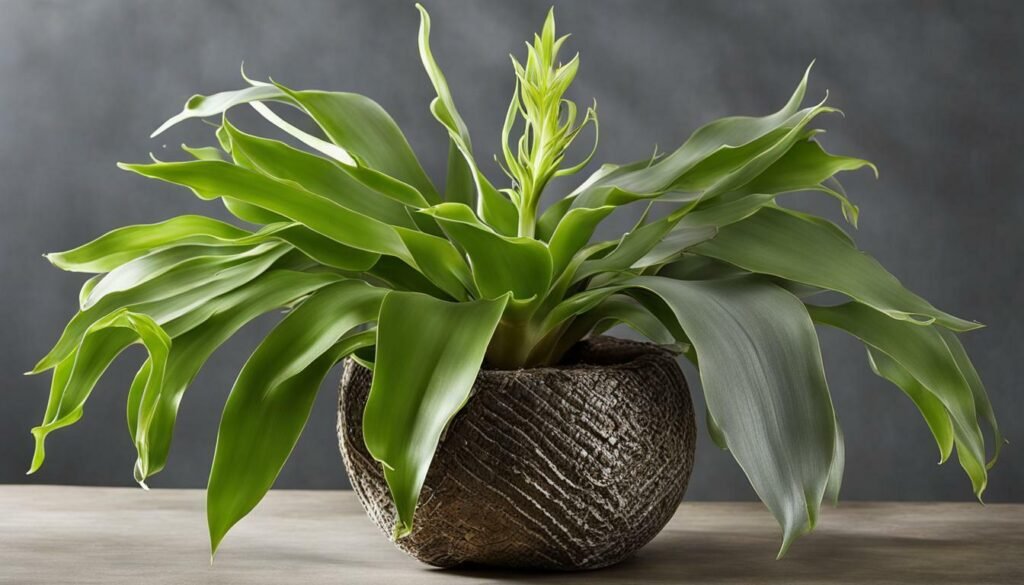Platycerium bifurcatum, commonly known as the Staghorn Fern, is an ornamental plant found in the rainforests of Java, New Guinea, and southeastern Australia. This popular species of staghorn fern is favored for its striking appearance and relative ease of cultivation. The plant features two types of fronds: sterile basal fronds that shield the rhizome and roots, and fertile or foliar fronds that can grow up to 18 inches long and produce spores on the underside. Staghorn ferns are epiphytes, meaning they do not grow in soil but instead attach themselves to trees or other supports.
Table of Contents
ToggleKey Takeaways:
- Platycerium bifurcatum, also known as the Staghorn Fern, is native to rainforests in Java, New Guinea, and southeastern Australia.
- The plant features sterile basal fronds that protect the rhizome and roots, as well as fertile or foliar fronds that produce spores.
- Staghorn ferns are epiphytes that attach themselves to trees or other supports.
- They require bright indirect light, warm temperatures, moderate humidity, and consistent moisture for optimal growth.
- Staghorn ferns can be propagated from spores or through division.
Native Habitat and Growth Habits
The Staghorn Fern, Platycerium bifurcatum, is native to the rainforests of Java, New Guinea, and southeastern Australia. It thrives in the humid and tropical climates of these regions, where it can be found growing on trees and other supports. The fern’s ability to attach itself to surfaces using its specialized rhizomes allows it to grow epiphytically, without the need for soil.
Its natural habitat in rainforests provides the Staghorn Fern with the ideal conditions for growth. The high levels of humidity, ample rainfall, and diffused light found in these environments create a perfect environment for the fern to flourish. It is often seen growing on tree trunks and branches, with its impressive fronds extending outward.
The Staghorn Fern has adapted to its epiphytic lifestyle by developing unique growth habits. The plant’s short rhizomes give rise to two distinct types of fronds. The sterile basal fronds, which are rounded to heart-shaped, serve to protect the rhizome and roots. Meanwhile, the fertile or foliar fronds are elongated, strap-like, and can reach up to 18 inches in length. These fronds bear the spores on their undersides, allowing for reproduction and the continuation of the species.
Overall, the Staghorn Fern’s ability to thrive in the rainforests of Java, New Guinea, and southeastern Australia is a testament to its resilience and adaptability as an epiphytic plant.
Staghorn Fern Facts and Figures
| Native Habitat | Growth Habits |
|---|---|
| Rainforests of Java, New Guinea, and southeastern Australia | Epiphytic; attaches to trees and other supports |
| Characteristics | Frond Types |
| Rhizomes, sterile basal fronds, fertile or foliar fronds | Protection and reproduction |
| Environmental Requirements | Preferred Conditions |
| Bright indirect light, warm temperatures, moderate humidity, consistent moisture | Optimal growth conditions |
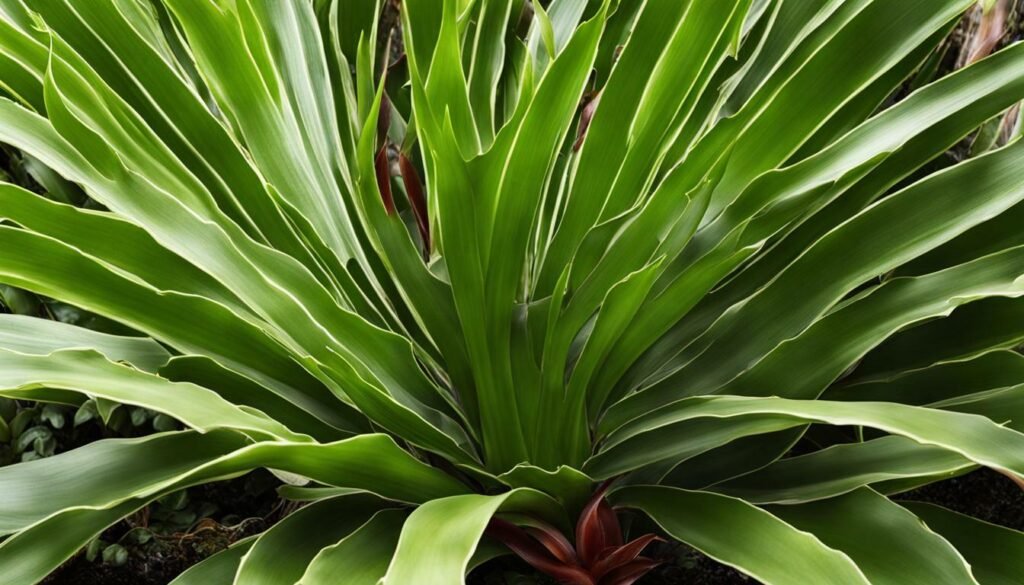
Morphology and Structure
The Staghorn Fern, Platycerium bifurcatum, grows from short rhizomes and has two types of fronds – sterile basal fronds and fertile or foliar fronds. These fronds give the plant its distinct appearance and play different roles in its growth and reproduction.
The sterile basal fronds are rounded to heart-shaped and serve as protective shields for the rhizome and roots. They form a dense layer that helps retain moisture and provides insulation. These fronds are typically green in color and grow horizontally, creating a sturdy base for the plant.
On the other hand, the fertile or foliar fronds are long, strap-like structures that can grow up to 18 inches in length. These fronds emerge from the center of the plant and curve gracefully outward. They are responsible for spore production, which occurs on the undersides of the fronds.
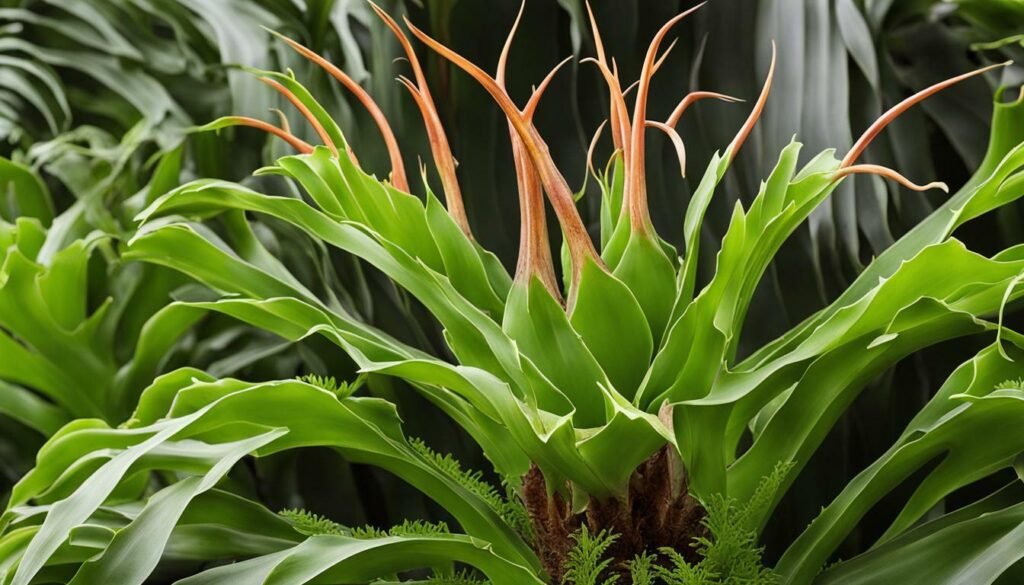
The Staghorn Fern’s unique frond structure allows it to adapt to its epiphytic lifestyle. By attaching itself to trees or other supports, it gains access to the nutrients and moisture it needs to thrive. The basal fronds provide a stable anchor, while the foliar fronds maximize exposure to light and air circulation.
In summary, the Staghorn Fern’s rhizomes give rise to two types of fronds – sterile basal fronds for protection and fertile or foliar fronds for reproduction. Together, these fronds create a visually striking plant that can adapt and flourish in its natural habitat.
Epiphytic Nature and Growth Requirements
As an epiphytic plant, the Staghorn Fern attaches itself to trees or other supports and requires certain conditions for optimal growth. These unique ferns are found in the rainforests of Java, New Guinea, and southeastern Australia, where they thrive by clinging to the bark of trees and absorbing nutrients from the air and rainwater. To replicate their natural habitat, it is important to provide Staghorn Ferns with the right environment at home.
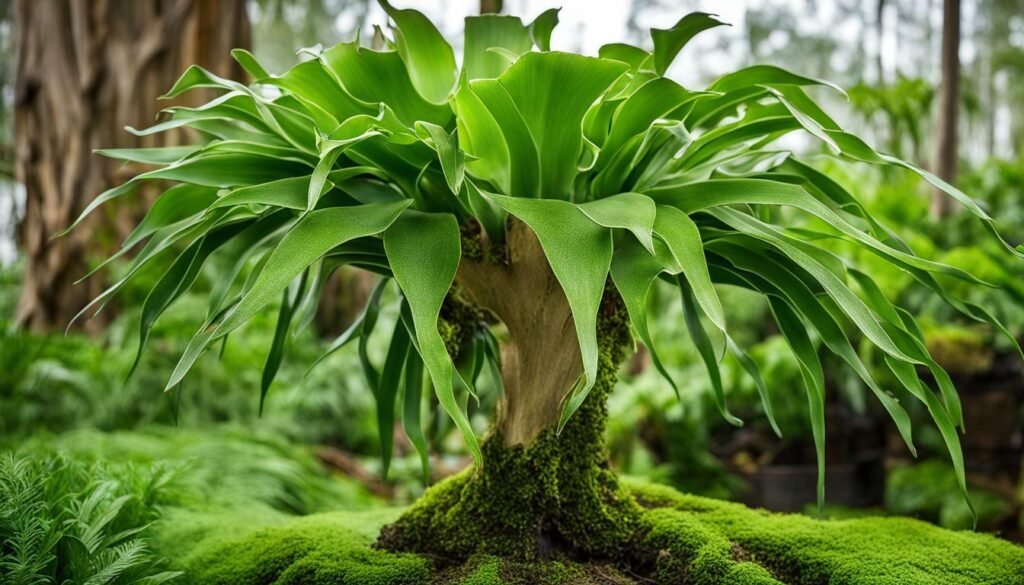
Staghorn Ferns prefer bright indirect light, which means they should not be exposed to direct sunlight as it can scorch their delicate fronds. Placing them near a north or east-facing window is ideal. They also require warm temperatures ranging from 70 to 90°F (21 to 32°C) and moderate humidity levels. If your home is dry, you can increase the humidity by misting the fronds with water.
Consistent moisture is crucial for the health of Staghorn Ferns. While they don’t grow in soil, their roots should be kept moist. A good watering technique is to mist the fronds and soak the roots in water for a few minutes. This can be done once or twice a week, depending on the humidity levels in your home. Overwatering should be avoided, as it can lead to root rot.
Proper fertilization is essential to support the growth of Staghorn Ferns. During their active growth period, which typically occurs in spring and summer, they should be fed with a balanced liquid fertilizer once a month. This will provide them with the necessary nutrients for healthy development and vibrant fronds.
Table: Staghorn Fern Growth Requirements
| Light | Temperature | Humidity | Watering | Fertilization |
|---|---|---|---|---|
| Bright indirect light | 70-90°F (21-32°C) | Moderate | Mist fronds and soak roots | Once a month with balanced liquid fertilizer |
With the right care and attention, Staghorn Ferns can thrive in your home and become a beautiful addition to your indoor garden. Remember to provide them with the necessary light, temperature, humidity, and watering conditions, and they will reward you with their stunning foliage.
Staghorn Fern Care
Proper care is crucial for the well-being of your Staghorn Fern and ensuring its longevity. This unique and beautiful plant requires specific conditions to thrive and display its characteristic vibrant green fronds. Here are some essential tips to help you provide the best care for your Staghorn Fern:
- Light: Staghorn Ferns prefer bright indirect light. Place them near a north or east-facing window where they can receive filtered sunlight throughout the day. Avoid direct sunlight as it can scorch the delicate fronds.
- Temperature and Humidity: Staghorn Ferns thrive in warm temperatures between 70-90°F (21-32°C) with moderate humidity. To maintain the ideal humidity level, you can mist the fronds daily or place a tray filled with water near the plant to increase moisture in the air.
- Watering: Staghorn Ferns have unique watering needs. Instead of traditional soil, they absorb moisture through their roots and fronds. To water your Staghorn Fern, mist the fronds regularly to mimic the natural conditions of rainforest environments. Additionally, soak the roots once every two weeks by placing the fern in a basin of water for about 10-20 minutes.
- Fertilization: Staghorn Ferns benefit from regular fertilization during the growing season (spring and summer). Use a balanced liquid fertilizer diluted to half strength and apply it once a month. This will provide the necessary nutrients to support healthy growth.
By following these care guidelines, your Staghorn Fern will thrive and become a stunning focal point in your home or garden. Remember to give it the attention it deserves, and it will reward you with its unique beauty and resilience.
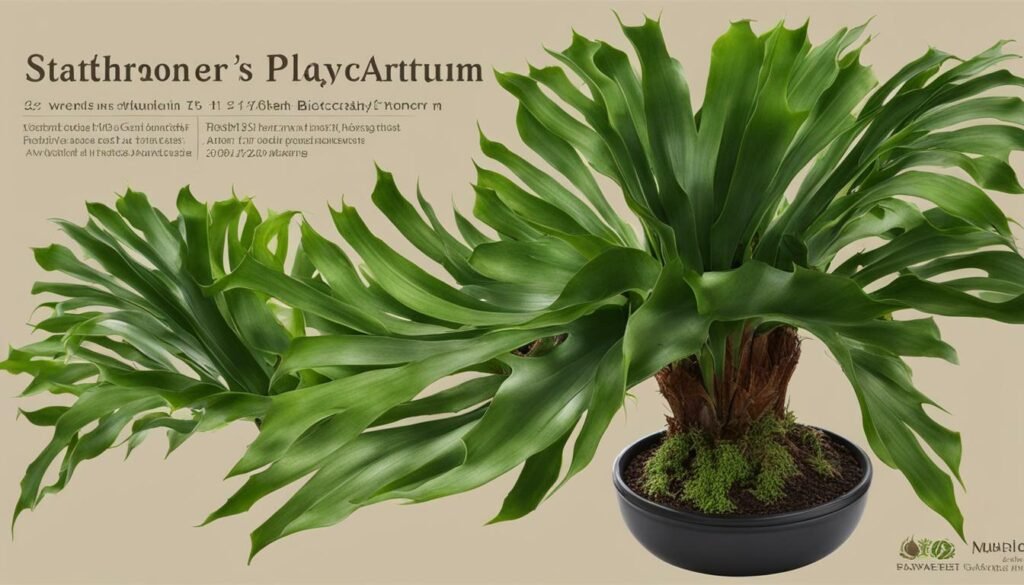
| Light | Temperature | Humidity | Watering | Fertilization |
|---|---|---|---|---|
| Bright indirect light | 70-90°F (21-32°C) | Moderate humidity | Mist fronds regularly and soak roots every two weeks | Apply balanced liquid fertilizer once a month during the growing season |
Staghorn Fern Propagation
Staghorn Ferns can be propagated either through spores or division. Propagation is an exciting and rewarding way to expand your collection of these stunning ferns. Let’s explore the two methods in detail.
Spore Propagation
Propagating Staghorn Ferns from spores requires patience and attention to detail. Begin by collecting mature spores from the fertile fronds. Place a piece of paper or a plastic bag beneath the frond to catch the spores as they fall. Allow the spores to dry for a few days, then carefully transfer them to a small container filled with a mixture of peat moss and perlite. Keep the container covered to maintain high humidity and place it in a warm and bright location. As the spores germinate and form tiny green heart-shaped gametophytes, mist them regularly to ensure moisture. It may take several months for these gametophytes to develop into recognizable ferns. Once they have grown large enough, they can be transplanted into a suitable growing medium.
Division Propagation
Division is a quicker method of propagating Staghorn Ferns and is best done during the plant’s active growth period. Carefully remove the fern from its mount or container, ensuring minimal disturbance to the roots. Gently divide the plant by separating the rhizomes and attached fronds into individual sections. Each section should have at least one healthy frond and a portion of the rhizome. Trim any damaged or dead fronds or roots. Plant the divisions onto a new mount or in separate containers filled with a well-draining medium, such as a mixture of orchid bark, sphagnum moss, and perlite. Keep the divisions in a warm and humid environment until they establish themselves.

Propagation opens up endless possibilities for expanding your Staghorn Fern collection or sharing these unique plants with friends and family. Whether you choose to propagate through spores or division, remember to provide the right conditions and care for the young ferns to ensure their successful growth. Happy propagating!
| Propagaion Method | Pros | Cons |
|---|---|---|
| Spore Propagation | – Exciting process of growing ferns from scratch – Can produce a large number of new plants – Suitable for fern enthusiasts and growers |
– Requires patience and time – Success rate can be lower compared to other methods – Requires specific conditions and attention to detail |
| Division Propagation | – Quicker method with higher success rate – Allows for immediate expansion of your fern collection – Suitable for beginners and those with limited time |
– Requires an existing mature plant for division – Can disrupt or damage the root system if not done carefully – May result in a limited number of new plants |
Mounting and Container Options
Choosing the right mounting or container option is essential for displaying your Staghorn Fern. These unique plants can be showcased in various creative ways, adding a touch of natural beauty to any space. Here are some popular options to consider:
- Mounting on a wooden board: This is a classic and rustic way to display your Staghorn Fern. Attach the fern to a wooden board using wire or nails. Be sure to use a sturdy and untreated board to avoid any potential harm to the plant.
- Hanging in a basket: Staghorn Ferns look stunning when suspended in a decorative hanging basket. Choose a basket with a wire frame to provide ample support for the fern. Line the basket with sphagnum moss to retain moisture and create a natural look.
- Mounted on a tree or branch: Embrace the epiphytic nature of the Staghorn Fern by mounting it directly on a tree trunk or branch. Use wire or flexible ties to secure the fern to the chosen surface, ensuring it has enough stability and room to grow.
- Container gardening: If you prefer a more versatile option, consider planting your Staghorn Fern in a decorative container. Use a well-draining potting mix and choose a container with drainage holes to prevent waterlogging. Terra cotta or ceramic pots can add an elegant touch to your indoor or outdoor space.
Remember to consider the needs of your Staghorn Fern when selecting a mounting or container option. Ensure that the chosen method allows for proper air circulation, as well as easy access for watering and maintenance. With the right display choice, your Staghorn Fern will become a captivating focal point in your home or garden.
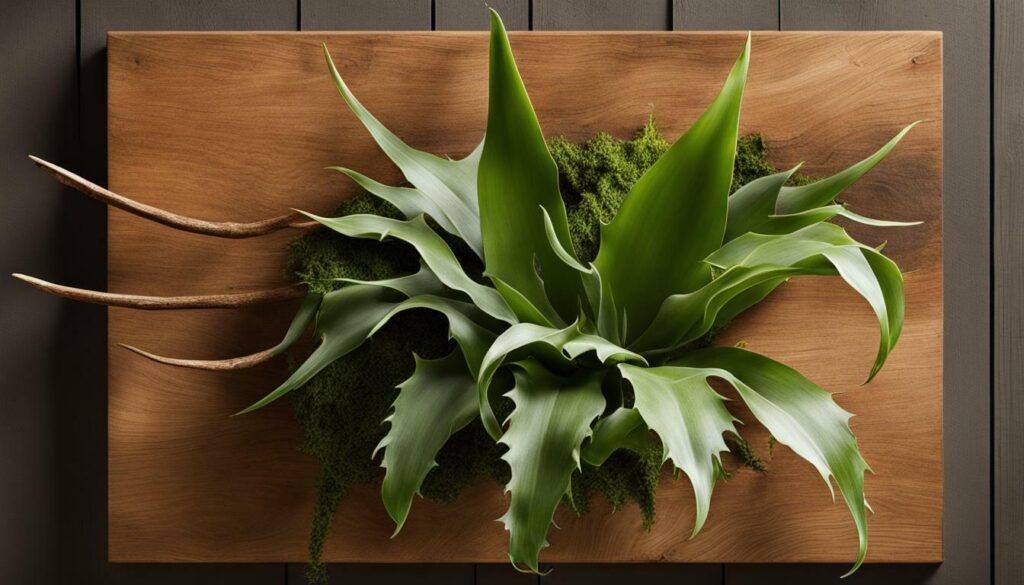
Table of Mounting and Container Options
| Mounting Option | Description |
|---|---|
| Wooden board | A classic and rustic choice, where the fern is attached to a sturdy wooden board. |
| Hanging basket | A decorative basket with a wire frame, lined with sphagnum moss for moisture retention. |
| Tree or branch | Mounting the fern directly on a tree trunk or branch, using wire or flexible ties for support. |
| Container gardening | Planting the fern in a decorative container with proper drainage, suitable for indoor or outdoor spaces. |
Proper Watering Techniques
Knowing how to water your Staghorn Fern correctly is vital for its overall health. As an epiphytic plant, Staghorn Ferns do not grow in soil but attached to trees or other supports. To mimic their natural environment, it’s essential to provide consistent moisture to both the fronds and the roots.
The best way to water a Staghorn Fern is through a combination of misting and soaking. Mist the fronds with room temperature water every few days to increase humidity and replicate the rainforest conditions. Misting also helps to prevent dust buildup on the fronds, keeping them clean and healthy.
Additionally, soak the roots of the Staghorn Fern once a week. This can be done by submerging the entire root ball in a container of water for 10-15 minutes. Ensure that the water reaches all parts of the root system for optimal hydration. After soaking, allow the excess water to drain off completely before reattaching the plant to its support.
It’s important to note that Staghorn Ferns are sensitive to overwatering. To prevent root rot and other water-related issues, make sure the plant is not sitting in water for prolonged periods. Proper drainage is essential, so consider using a well-draining potting mix and a container with drainage holes.
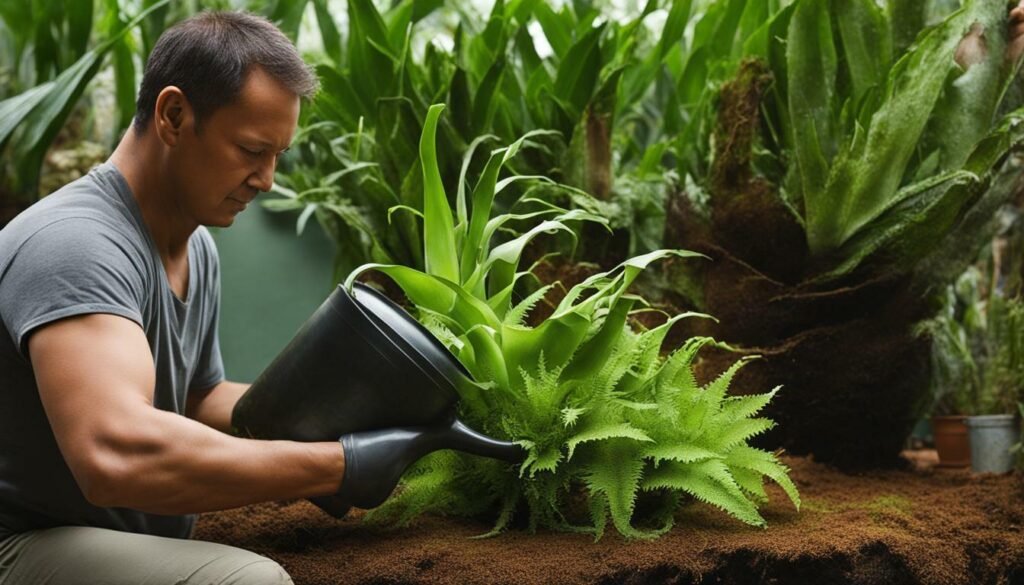
| Watering Method | Frequency | Tips |
|---|---|---|
| Misting | Every few days | Use room temperature water and mist the fronds thoroughly, focusing on the underside where spores are produced. |
| Soaking | Once a week | Submerge the entire root ball in water for 10-15 minutes, allowing the excess water to drain off completely before reattaching the plant. |
| Drainage | N/A | Ensure proper drainage by using a well-draining potting mix and a container with drainage holes. |
Sunlight Requirements
Understanding the sunlight needs of your Staghorn Fern is key to its success. As an epiphytic plant, the Staghorn Fern thrives in bright indirect light. Placing it near a north or east-facing window is ideal, as it will receive adequate light without the risk of direct exposure to the intense midday sun. If you don’t have a suitable window, you can also provide artificial light using fluorescent grow lights.
It’s important to note that Staghorn Ferns are adaptable and can tolerate varying light conditions, but prolonged exposure to direct sunlight can scorch their delicate fronds. If you notice the fronds turning brown or yellow, it may be a sign of sunburn, and you should consider moving the plant to a shadier spot.
Remember to periodically rotate your Staghorn Fern to ensure even light distribution. This will help prevent the fronds from leaning towards the light source and promote balanced growth. With the right amount of light, your Staghorn Fern will develop vibrant green fronds that showcase its unique and captivating beauty.

| Light Intensity | Light Duration |
|---|---|
| Bright Indirect Light | 8-10 hours per day |
| Artificial Grow Lights | 12-14 hours per day |
Nutrient Needs and Fertilization
Providing adequate nutrients and fertilization is essential for the healthy growth of your Staghorn Fern. These plants have specific nutrient requirements that can be met through regular fertilization. Staghorn Ferns require a balanced liquid fertilizer with equal amounts of nitrogen (N), phosphorus (P), and potassium (K). This ensures that the plant receives the necessary macronutrients to thrive.
When fertilizing your Staghorn Fern, it is best to dilute the fertilizer to half the recommended strength and apply it once a month during the growing season. This allows for sufficient nutrient uptake without the risk of overfertilization. Apply the diluted fertilizer directly to the sterile basal fronds and avoid getting it on the fertile or foliar fronds.
Additionally, it is important to note that Staghorn Ferns are sensitive to salt buildup in the root system, which can be caused by excess fertilizer. To prevent salt accumulation, water the plant thoroughly after each fertilization to flush out any excess salts. This promotes healthy root growth and prevents damage to the plant.
| Nutrients | Function | Sources |
|---|---|---|
| Nitrogen (N) | Stimulates leaf and stem growth | Fish emulsion, compost, blood meal |
| Phosphorus (P) | Promotes root development and flowering | Bone meal, rock phosphate |
| Potassium (K) | Enhances overall plant health and disease resistance | Wood ash, kelp meal, greensand |
By providing the proper nutrients and fertilization, you can ensure that your Staghorn Fern thrives and remains healthy. With proper care, these ferns can be a stunning addition to any indoor or outdoor space, adding a touch of natural beauty.
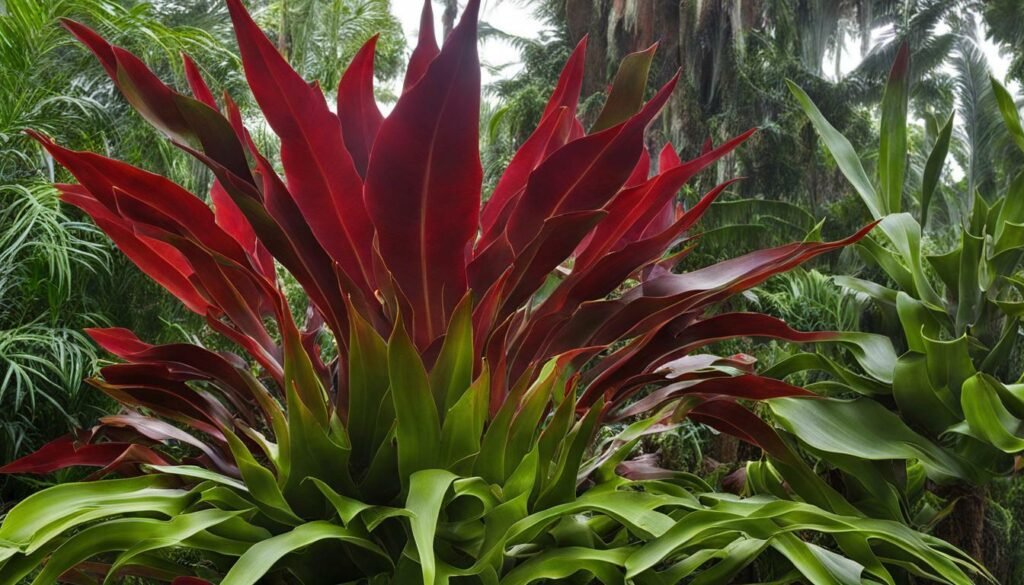
Conclusion
In conclusion, the Staghorn Fern, also known as Platycerium bifurcatum, is a fascinating plant that requires specific care to thrive in your living space. Native to the rainforests of Java, New Guinea, and southeastern Australia, this ornamental plant is the most commonly cultivated species of staghorn fern. Its unique growth habits and epiphytic nature make it an intriguing addition to any indoor garden.
The Staghorn Fern grows from short rhizomes that produce two types of fronds. The sterile basal fronds, rounded to heart-shaped, protect the rhizome and roots. On the other hand, the fertile or foliar fronds are strap-like and can grow up to 18 inches long, with spores produced on the underside. It is recommended to mount or containerize the Staghorn Fern, as it attaches to trees or other supports in its natural habitat.
To ensure the Staghorn Fern thrives, it requires bright indirect light, warm temperatures, and moderate humidity. It is essential to provide consistent moisture by misting the fronds and soaking the roots. Additionally, regular fertilization with a balanced liquid fertilizer during active growth will help maintain the plant’s health and vitality. The Staghorn Fern can be propagated through spores or by division, providing an opportunity to expand your collection or share this unique plant with others.
If you are looking to add a touch of natural beauty to your home, the Staghorn Fern is an excellent choice. With its striking appearance and specific care requirements, it will undoubtedly become a focal point in any indoor space. So, why not embark on the journey of nurturing and enjoying this captivating plant?
FAQ
What is the scientific name of the Staghorn Fern?
The scientific name of the Staghorn Fern is Platycerium bifurcatum.
Where is the Staghorn Fern native to?
The Staghorn Fern is native to the rainforests of Java, New Guinea, and southeastern Australia.
How does the Staghorn Fern grow?
The Staghorn Fern grows from short rhizomes and produces two types of fronds – sterile basal fronds and fertile or foliar fronds.
What are the growth requirements for Staghorn Ferns?
Staghorn Ferns require bright indirect light, warm temperatures, moderate humidity, and consistent moisture.
How should I water my Staghorn Fern?
Staghorn Ferns should be watered by misting the fronds and soaking the roots.
How can I propagate Staghorn Ferns?
Staghorn Ferns can be propagated from spores or by division.
